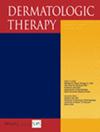Clinical Characteristics and Treatment of Acne with Sensitive Skin
IF 3.7
4区 医学
Q1 DERMATOLOGY
引用次数: 0
Abstract
Background. Acne is a prevalent skin disorder that primarily affects seborrheic areas. It occurs due to hair follicle obstruction and subsequent inflammation. Patients with acne often exhibit compromised skin barrier function and sensitivity, making treatment challenging. Objectives. This study aimed to investigate the occurrence of acne complicated by sensitive skin and explore the associated physiological changes. Methods. The lactic acid test and capsaicin test were employed to identify subjects with simple acne and those with acne and sensitive skin. Physiological characteristics were assessed in both groups. Two random groups were selected from the subjects with acne and sensitive skin. One group received treatment for acne alone, while the other group received combined treatment for acne and sensitive skin care. The efficacy and physiological function of the two groups were compared after treatment. Results. Among 170 acne patients, 99 were identified as having acne with sensitive skin. Patients with acne and sensitive skin exhibited significantly higher scores on the lactic acid test and capsaicin test compared to those with simple acne. They also showed increased transepidermal water loss (TEWL), decreased skin cuticle hydration (SCH), thinner epidermis, and thicker blood vessels. The group receiving combined treatment demonstrated a more significant reduction in the number of skin lesions and IGA scores compared to the group receiving treatment for acne alone. They also exhibited lower scores on the lactate and capsaicin tests, along with decreases in TEWL and increases in SCH. Conclusions. Acne with sensitive skin is highly prevalent and is associated with distinct physiological characteristics. Combined treatment targeting both acne and sensitive skin yields excellent clinical outcomes and improves skin’s physiological function. These findings underscore the importance of considering sensitive skin in the clinical management of acne.敏感皮肤痤疮的临床特点及治疗
背景。痤疮是一种普遍的皮肤病,主要影响脂溢性区域。它是由毛囊阻塞和随后的炎症引起的。痤疮患者往往表现出受损的皮肤屏障功能和敏感性,使治疗具有挑战性。目标。本研究旨在探讨痤疮并发敏感皮肤的发生及相关的生理变化。方法。采用乳酸试验和辣椒素试验对单纯性痤疮和痤疮敏感皮肤进行鉴别。评估两组患者的生理特征。从痤疮和敏感皮肤的受试者中随机选择两组。一组单独治疗痤疮,另一组联合治疗痤疮和敏感皮肤护理。比较两组治疗后的疗效和生理功能。结果。在170例痤疮患者中,有99例被确定为敏感皮肤痤疮。痤疮和敏感皮肤患者在乳酸测试和辣椒素测试中得分明显高于单纯痤疮患者。他们还表现出经皮失水(TEWL)增加,皮肤角质层水合作用(SCH)减少,表皮变薄,血管变厚。与单独接受痤疮治疗的组相比,接受联合治疗的组在皮肤病变数量和IGA评分方面表现出更显著的减少。他们在乳酸和辣椒素测试中也表现出较低的分数,同时TEWL下降,SCH增加。敏感皮肤的痤疮是非常普遍的,并与不同的生理特征有关。针对痤疮和敏感皮肤的联合治疗取得了良好的临床效果,改善了皮肤的生理功能。这些发现强调了在痤疮的临床治疗中考虑敏感皮肤的重要性。
本文章由计算机程序翻译,如有差异,请以英文原文为准。
求助全文
约1分钟内获得全文
求助全文
来源期刊

Dermatologic Therapy
医学-皮肤病学
CiteScore
7.00
自引率
8.30%
发文量
711
审稿时长
3 months
期刊介绍:
Dermatologic Therapy has been created to fill an important void in the dermatologic literature: the lack of a readily available source of up-to-date information on the treatment of specific cutaneous diseases and the practical application of specific treatment modalities. Each issue of the journal consists of a series of scholarly review articles written by leaders in dermatology in which they describe, in very specific terms, how they treat particular cutaneous diseases and how they use specific therapeutic agents. The information contained in each issue is so practical and detailed that the reader should be able to directly apply various treatment approaches to daily clinical situations. Because of the specific and practical nature of this publication, Dermatologic Therapy not only serves as a readily available resource for the day-to-day treatment of patients, but also as an evolving therapeutic textbook for the treatment of dermatologic diseases.
 求助内容:
求助内容: 应助结果提醒方式:
应助结果提醒方式:


